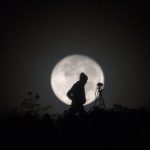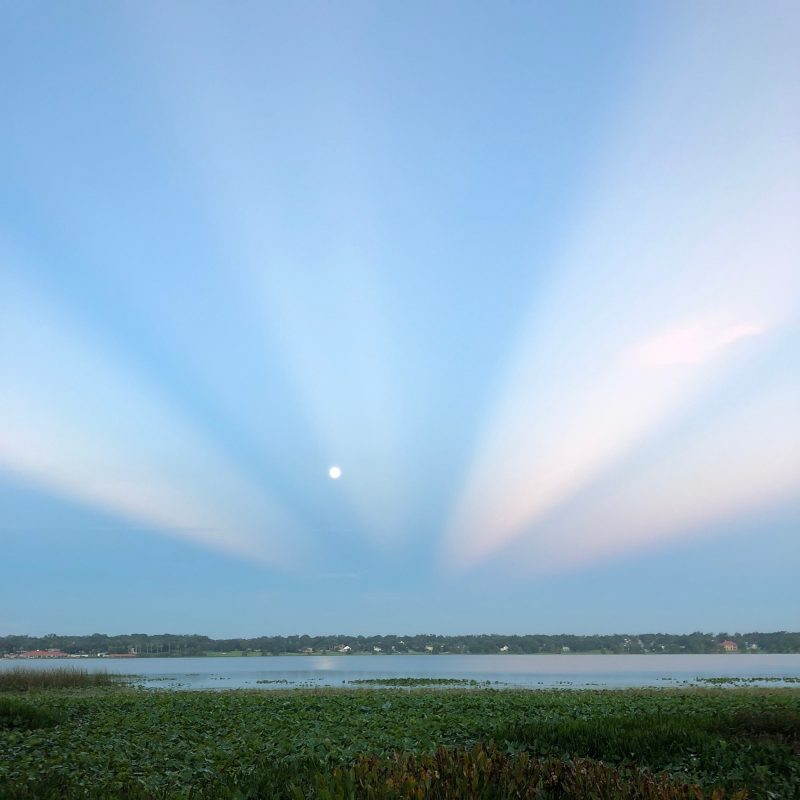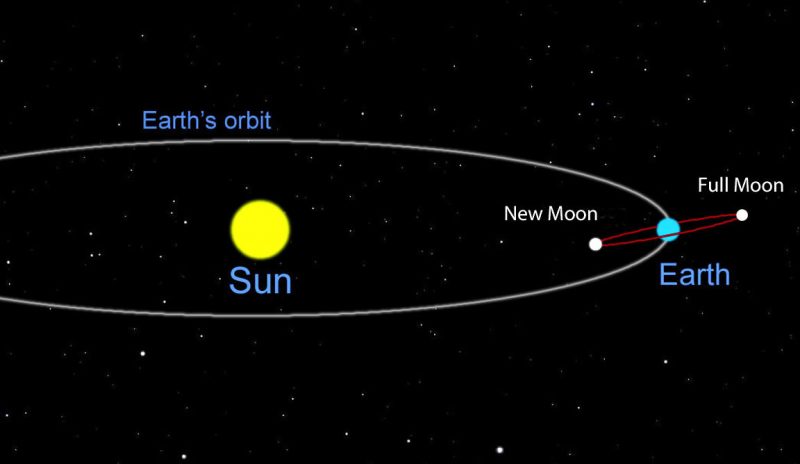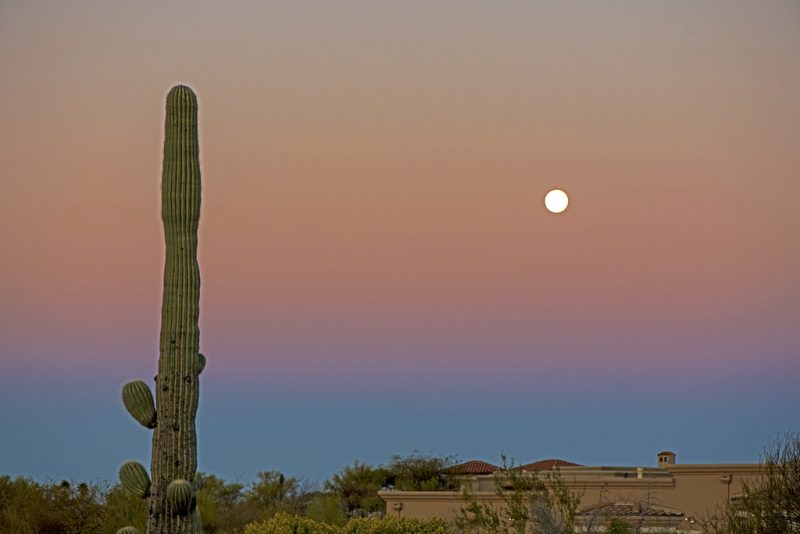

A full moon, rising around the time of sunset, in the midst of anticrepuscular rays. Both these sorts of rays and a full moon are always opposite the sun. Stefanie Bush in Lakeland, Florida caught this image with an IphoneX. Thanks, Stefanie!
Half the moon is always illuminated by the sun. That lighted half is the moon’s day side. In order to appear full to us on Earth, we have to see the whole day side of the moon. That happens only when the moon is opposite the sun in our sky. A full moon is a moon opposite the sun. That’s why every full moon rises in the east around sunset – climbs highest up for the night midway between sunset and sunrise (around midnight) – and sets around sunrise.
Technically speaking, the moon is full at the instant it’s 180 degrees from the sun in ecliptic longitude. Want to know the instant of full moon in your part of the world, as well as the moonrise and moonset times? Click here, remembering to check the moon phases plus moonrise and moonset boxes.
Or you can just stand outside around sunset and look for the moon. Sun going down while the moon is coming up? That’s a full moon, or close to one.
The moon looks full for at least a couple of night around the instant of full moon.

A full moon is opposite the sun. We see all of its dayside. Illustration via Bob King.
Often, you’ll find two different dates on calendars for the date of full moon. That’s because some calendars list moon phases in Coordinated Universal Time or Universal Time Coordinated (UTC). And other calendars list moon phases in local time, a clock time of a specific place, usually the place that made and distributed the calendars. Click here to translate UTC to your local time.
If a full moon is opposite the sun, why doesn’t Earth’s shadow fall on the moon at every full moon? The reason is that the moon’s orbit is titled by 5.1 degrees with respect to Earth’s orbit around the sun. At every full moon, Earth’s shadow sweeps near the moon. But, in most months, there’s no eclipse.

A full moon normally passes above or below Earth’s shadow, with no eclipse. Illustration by Bob King.

Full moon and Earth’s shadow on the morning of March 2, 2018 via Eliot Herman in Tucson, Arizona.
As the moon orbits Earth, it changes phase in an orderly way. Follow these links to understand the various phases of the moon.
New moon
Waxing crescent moon
First quarter moon
Waxing gibbous moon
Full moon
Waning gibbous moon
Last quarter moon
Waning crescent moon
Read more: 4 keys to understanding moon phases
Read more: What are the full moon names?
Bottom line: Full moon – when the moon is most opposite the sun for this month – happens on September 25 at 2:52 UTC; translate UTC to your time. Plus, why a full moon looks full.
Check out EarthSky’s guide to the bright planets.
Help EarthSky keep going! Please donate.
from EarthSky https://ift.tt/1iAoPbQ


A full moon, rising around the time of sunset, in the midst of anticrepuscular rays. Both these sorts of rays and a full moon are always opposite the sun. Stefanie Bush in Lakeland, Florida caught this image with an IphoneX. Thanks, Stefanie!
Half the moon is always illuminated by the sun. That lighted half is the moon’s day side. In order to appear full to us on Earth, we have to see the whole day side of the moon. That happens only when the moon is opposite the sun in our sky. A full moon is a moon opposite the sun. That’s why every full moon rises in the east around sunset – climbs highest up for the night midway between sunset and sunrise (around midnight) – and sets around sunrise.
Technically speaking, the moon is full at the instant it’s 180 degrees from the sun in ecliptic longitude. Want to know the instant of full moon in your part of the world, as well as the moonrise and moonset times? Click here, remembering to check the moon phases plus moonrise and moonset boxes.
Or you can just stand outside around sunset and look for the moon. Sun going down while the moon is coming up? That’s a full moon, or close to one.
The moon looks full for at least a couple of night around the instant of full moon.

A full moon is opposite the sun. We see all of its dayside. Illustration via Bob King.
Often, you’ll find two different dates on calendars for the date of full moon. That’s because some calendars list moon phases in Coordinated Universal Time or Universal Time Coordinated (UTC). And other calendars list moon phases in local time, a clock time of a specific place, usually the place that made and distributed the calendars. Click here to translate UTC to your local time.
If a full moon is opposite the sun, why doesn’t Earth’s shadow fall on the moon at every full moon? The reason is that the moon’s orbit is titled by 5.1 degrees with respect to Earth’s orbit around the sun. At every full moon, Earth’s shadow sweeps near the moon. But, in most months, there’s no eclipse.

A full moon normally passes above or below Earth’s shadow, with no eclipse. Illustration by Bob King.

Full moon and Earth’s shadow on the morning of March 2, 2018 via Eliot Herman in Tucson, Arizona.
As the moon orbits Earth, it changes phase in an orderly way. Follow these links to understand the various phases of the moon.
New moon
Waxing crescent moon
First quarter moon
Waxing gibbous moon
Full moon
Waning gibbous moon
Last quarter moon
Waning crescent moon
Read more: 4 keys to understanding moon phases
Read more: What are the full moon names?
Bottom line: Full moon – when the moon is most opposite the sun for this month – happens on September 25 at 2:52 UTC; translate UTC to your time. Plus, why a full moon looks full.
Check out EarthSky’s guide to the bright planets.
Help EarthSky keep going! Please donate.
from EarthSky https://ift.tt/1iAoPbQ


Aucun commentaire:
Enregistrer un commentaire